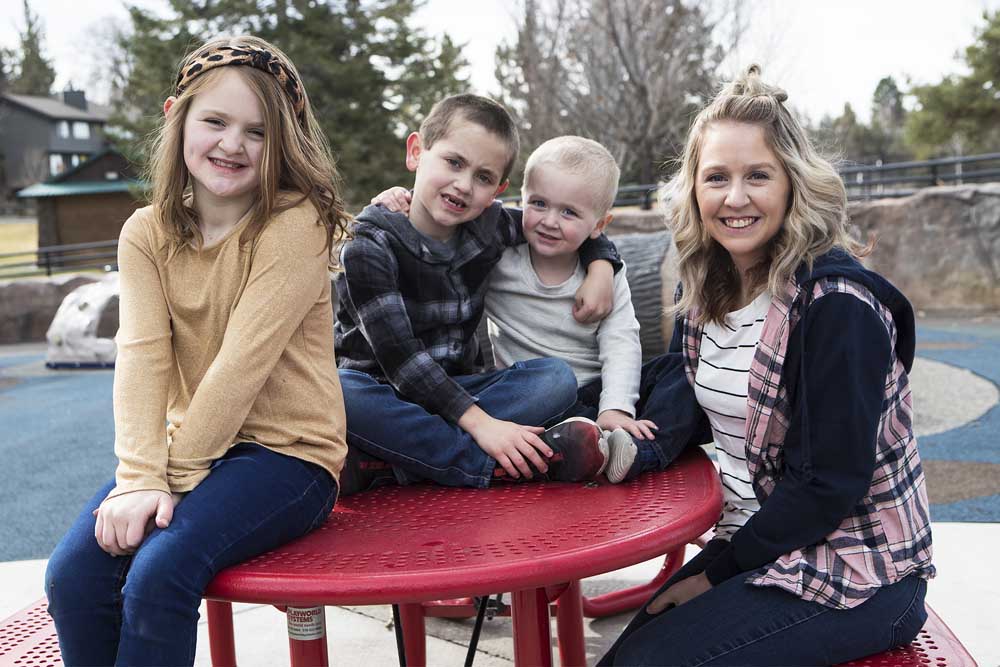No child care slots, Central Oregon mom instead finds flexible employer
Published 5:00 am Sunday, March 20, 2022

- Kristen Ramirez and her three children Alexa, from left, Wyatt and Clay at Sam Johnson Park in Redmond on Friday, March 18, 2022.
Kristen Ramirez turned down six job offers before she found one that let her take care of her children.
The Redmond mother was surprised when the staff at the Central Oregon Dental Center offered her a job on the spot, saying they’d be able to cover her in the office if she needed time off for snow days or other school conflicts.
“It was kind of unheard of — I was pretty shocked,” Ramirez said a few days after she got the job. “Just that I was able to take a job based on qualifications and not based on whether or not I have child care.”
The troubles families are having with finding child care do not end when kids are off to kindergarten. Hundreds of families across the region struggle to find safe and affordable places for their children to be between when the school day ends and parents are off work, and the limited programs in the region are struggling to keep up.
Even before the pandemic turned the labor market on its head, the availability of school-aged child care was dismal. There were enough child care slots for just 16% of Deschutes County’s 6-to-12-year-olds, according to a study of 2020 availability by Oregon State University researchers.
No available child care meant Ramirez had to find an amenable employer. The first six jobs Ramirez applied for — mostly at other dental offices, and one at a local school — since moving to the region early this year were not flexible about her family’s child care needs.
The situation isn’t complex: Clay, 3, just started day care, leaving only a few hours of the day before and after school and outside of the normal workday during which Alexa, 9, and Wyatt, 7, needed a safe place to be.
The 34-year-old feels fortunate she found a job that fits within her child care needs, but she was close to calling it quits. She might have stayed out of the workforce altogether until her kids were old enough to drive themselves to school if she had turned down another offer.
“I’ve probably been offered more jobs here than in the last like 10 years, just because there are so many work opportunities right now with the economy,” Ramirez told The Bulletin the day before her latest job interview. “Getting those and being offered positions and then literally having to turn them down because of not having child care is disheartening. It’s a hard pill to swallow.”
After-school programs struggle to recruit and retain
Ramirez tried to get her school-aged children into Champions, the after-school program that operates in Redmond School District elementary schools, but moving to the area in the middle of the school year, the only space available was on the waitlist.
Programs across the region have faced a similar capacity squeeze, and many point to staffing as the issue.
This school year, KIDS Inc., the after-school program hosted in Bend-La Pine Schools’ elementary schools by the Bend Park & Recreation District, has had to reduce its capacity by about 35% because there are 30 fewer employees than needed.
That’s about 400 kids who would have been able to participate in previous years that can’t this year, according to Matt Mercer, the district’s recreation director. While in previous years, the availability of physical space has been the program’s limiting factor, this year it’s almost entirely a staffing problem.
“We typically have openings, and it’s a meaningful job I think,” Mercer said. “I think at the same token, it’s not really sustainable for a lot of people, so they end up moving on to full time, and/or higher-paying positions.”
The Boys & Girls Club, Bend’s other large after-school child care option, is experiencing a very similar problem. Its two locations can only accommodate 140 children, 40 fewer than normal because of four missing staff members, according to Bess Goggins, the nonprofit’s CEO. Those 40 lost spots make a difference, she said.
“When our school-age kids get out of school in the afternoon or they’re out of school in the summer, they need a safe space filled with learning and self-discovery that they can go to that allows families to focus on their workdays and to know that their child or children are being well cared for,” Goggins said.
College tuition for child care staff
For KIDS Inc., park district leaders are hoping to make Kids Inc. staffing jobs — part-time jobs with an awkward five-day schedule heavily dependent on the school calendar — more attractive.
To do that, the district wants to pay employees’ college tuition.
Under a plan approved by the park and recreation board in the past week, the district will offer Central Oregon Community College and Oregon State University-Cascades students who work for KIDS Inc. 18 to 20 hours a week in $5,250 scholarships.
Combined with the hourly wages students will be paid, Mercer projects that participation in the program would cover the estimated full-time cost at COCC or much of the cost for full-time OSU-Cascades students.
“Hopefully it’s something that attracts some people as well — you know, that’s something people could do for four years if they wanted to, two years, whatever,” Mercer said.
In addition to a partnership with Bend-La Pine Schools launching in the fall to give high schoolers paid internships if they commit to staffing KIDS Inc., Mercer hopes the scholarship program will help to backfill the program’s significant staffing needs. The district’s goal for the first year is to hire 12 or more college students with the scholarship program and fill 12 positions with high schoolers.
Still, BPRD’s new recruitment programs won’t start until the fall. That means KIDS Inc. is just trying to survive the rest of this school year, according to Mercer.
For the Boys & Girls Clubs’ part, Goggins said the nonprofit hopes to expand to a third location in the future. But that’ll take time, space and staff.
And even if both programs find ways to scale up, the need won’t be filled — hundreds sit on their waitlists every year, and many families have stopped trying to get on the waitlists at all.
Ramirez thinks the solution lies in workplaces allowing more flexibility in scheduling around school schedules, or school systems including before- and after-school care in their budgets.
Sami Martin, a single mother of a kindergartener at Ponderosa Elementary School in Bend, echoes those hopes. She thinks the availability of after-school programs should be expanded by public sources, and additional financial support should be available for single parents like her.
Self-employed, doing housecleaning, Uber and Instacart jobs, Martin’s schedule has flexibility — but she still needs those few working hours each afternoon in order to make enough money to pay her rent. She’s stopped looking for openings in after-school programs, opting to have a friend pick up her son from school each day instead.
But if that friend is sick, or otherwise can’t pick up Martin’s son, she’s got to stop working. As her family’s sole source of income, that’s not something she can afford to do too often.
“It’s a struggle for sure, for both working parents and single parents,” Martin said. “It is a struggle and it sucks. We all want the best for our kids, but at the same time as adults, we have these financial responsibilities that there’s no getting around.”






